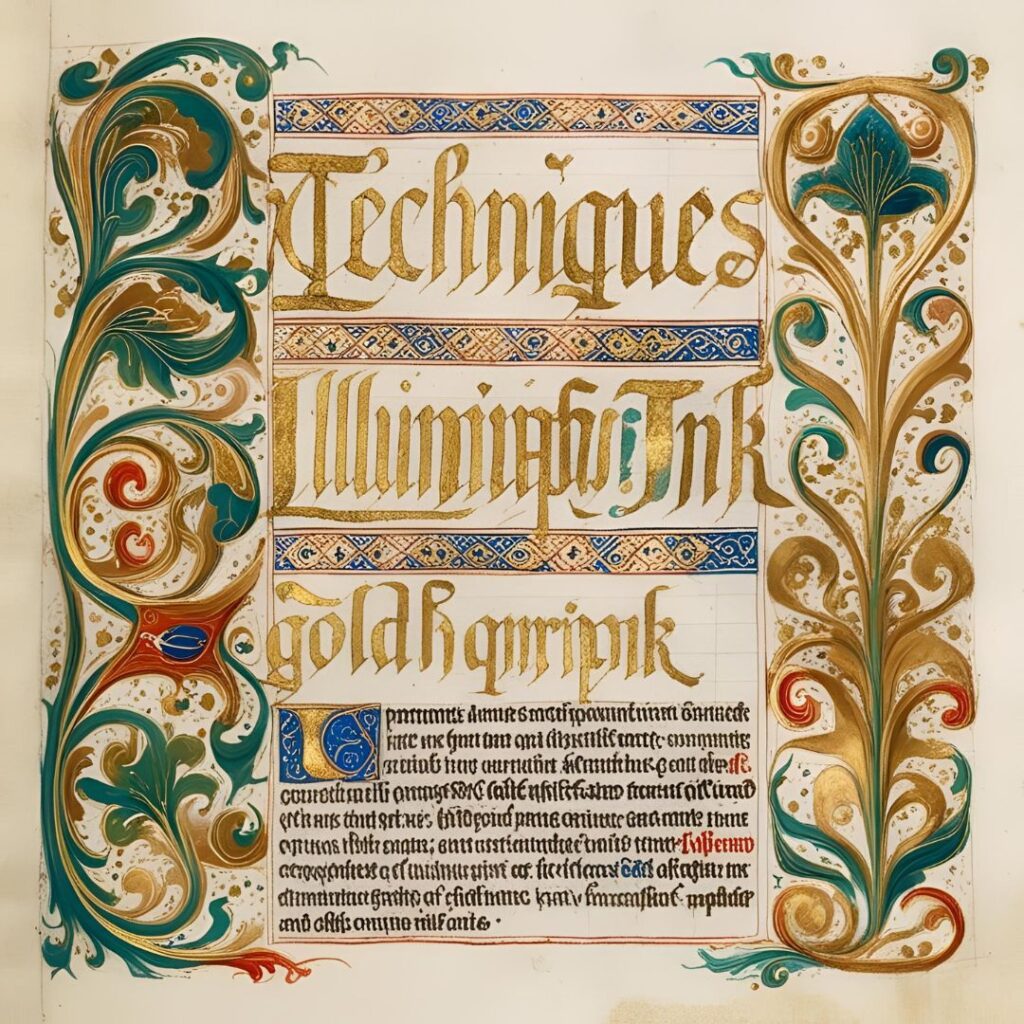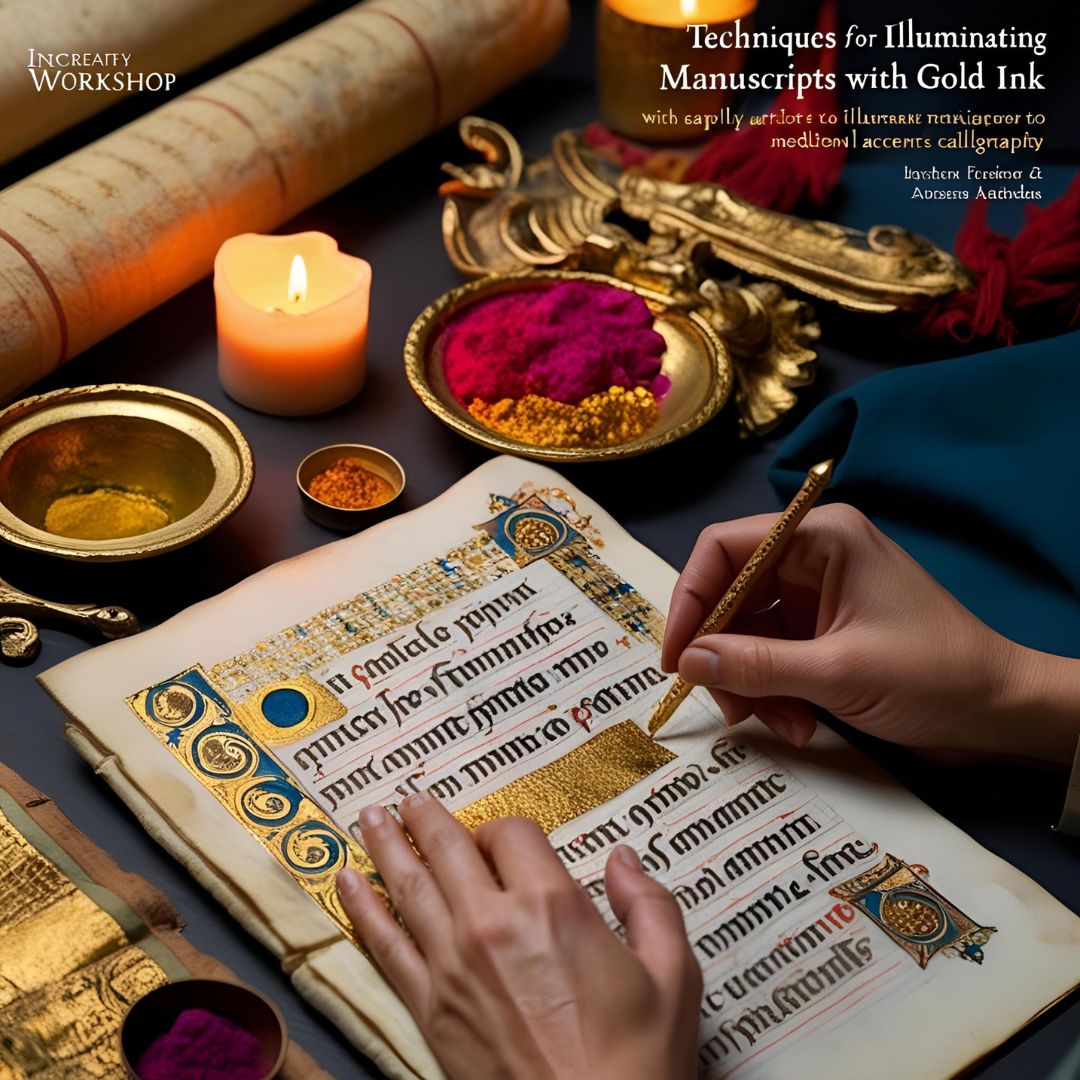Learn how to apply gold ink and luxurious elements to manuscripts to create stunning effects. Discover gold leaf, metallic inks, and medieval illumination techniques to enhance your calligraphy projects
Medieval manuscripts are known for their beauty and visual richness, often adorned with elaborate details such as gold ink illuminations. The art of illuminating manuscripts is not just an aesthetic practice but also a reflection of the importance and reverence of sacred or noble texts. In this post, we will explore the techniques of medieval illumination, focusing on the application of gold ink and other luxurious elements that create stunning effects. Whether you’re a calligrapher or a medieval art enthusiast, learning how to add these special touches to your calligraphy can completely transform your projects.

What Are Illuminations and Why Are They Important?
Illumination in medieval manuscripts is an artistic process that involves decorating texts, especially at the beginning of paragraphs, chapters, or on the margins of pages. The illumination technique was used to highlight important passages of the text, often to symbolize the sacredness or status of the book. The use of metallic inks, such as gold and silver, was common to create a striking contrast with the background and add a dimension of sophistication.
Gold ink, in particular, was chosen for its brilliance and richness and was frequently used for religious texts or important documents. The use of gold leaf and gold ink was a symbol of prestige and power.
Materials Needed for Gold Ink Illumination
Before diving into the illumination techniques, it’s essential to have the right materials. Here are the key items you’ll need to add gold ink to your manuscripts:
- Gold Leaf: Gold leaf is an essential material when it comes to traditionally illuminating manuscripts. It comes in various thicknesses, with the thinnest leaf being ideal for applying to margins and text details.
- Gold Ink or Metallic Ink: In addition to gold leaf, you can use metallic gold ink. There are several options available in the market, such as acrylic-based inks or calligraphy-specific inks that can be used to create bright and sophisticated details.
- Fine Brushes: High-quality brushes with soft, precise bristles are essential for applying gold ink or gold leaf in a controlled manner.
- Quality Paper: The type of paper is also crucial. Smooth, thick paper helps the metallic ink or gold leaf adhere and prevents the paper from absorbing the ink unevenly.
- Arabic Gum: Used as an adhesive for gold leaf, Arabic gum is a natural glue that helps ensure the gold leaf sticks evenly to the paper.
Step-by-Step Guide to Illuminating Manuscripts with Gold Ink
Now that you have all the materials ready, let’s take a look at the practical steps for adding gold ink and gold leaf to your manuscript.
1. Preparing the Text for Illumination
Before adding any gold elements, it’s important to finish your calligraphy. Use a high-quality calligraphy pen, such as a dip pen or steel nib, to create elegant letters and text. Make sure the text is completely dry before starting the illumination process.
2. Applying Arabic Gum
If you’re using gold leaf, the first step is to apply a thin layer of Arabic gum to the area where you want to apply the leaf. Use a small, fine brush to spread the gum evenly. Arabic gum will help the gold leaf adhere properly.
3. Applying Gold Leaf
After applying the Arabic gum and letting it dry for a few minutes, carefully place the gold leaf onto the adhesive area. Use tweezers to hold the gold leaf and position it where you want it. Gently press the gold leaf onto the paper using a soft brush.
If the gold leaf tears or doesn’t cover the area entirely, don’t worry — you can easily fix this by adding more sheets or overlapping the torn parts. Overlapping the gold leaf can also create a textured effect, which can be quite interesting.
4. Applying Gold Ink or Metallic Ink
For those who prefer a simpler approach or a subtler effect, gold ink can be an excellent alternative. Using a fine brush, apply the gold ink to the areas you want to highlight, such as the first letters of a paragraph or the margins. Metallic ink can be applied lightly or thickly, depending on the effect you want.
5. Finishing the Illumination
Once you’ve applied the gold leaf or ink, allow the manuscript to dry completely. To achieve a polished finish, you can gently rub a soft cloth over the gold leaf to add extra shine. If necessary, use a fine brush to touch up any areas that may have been accidentally affected.
Tips for Creating Manuscripts with Gold Ink
Here are some practical tips to maximize the impact of your illuminations and create stunning medieval manuscripts:
- Use Gold Ink in Small Details: Instead of covering large areas with gold leaf, focus on small details, such as initial letters, margins, or decorative symbols. This creates a contrasting effect without overwhelming the manuscript.
- Combine Gold and Silver: For an even more sophisticated effect, combine gold leaf with silver leaf. Silver provides a sense of balance and can be used in complementary areas to contrast with the gold.
- Incorporate Decorative Elements: In addition to the lettering, use decorative elements like flowers, leaves, and medieval symbols around the text. These can be done with gold or silver ink to create a rich, ornate composition.
- Get Creative with the Background: A dark background, such as black or brown ink, creates an impressive contrast with gold ink. Experiment with different color combinations to find the one that suits your style and project best.
Illuminating manuscripts with gold ink is a fascinating technique that brings out the richness and beauty of medieval manuscripts. With the careful application of gold leaf and metallic inks, you can transform your calligraphy projects into stunning works of art full of elegance. Practicing these techniques will add a historic and refined touch, allowing you to create pieces that honor medieval traditions while breathing life into any artistic project. Follow the steps, experiment, and add your personal touch to create beautiful and immersive manuscripts.









